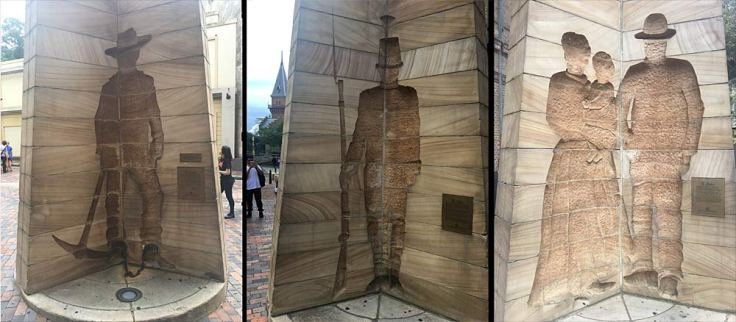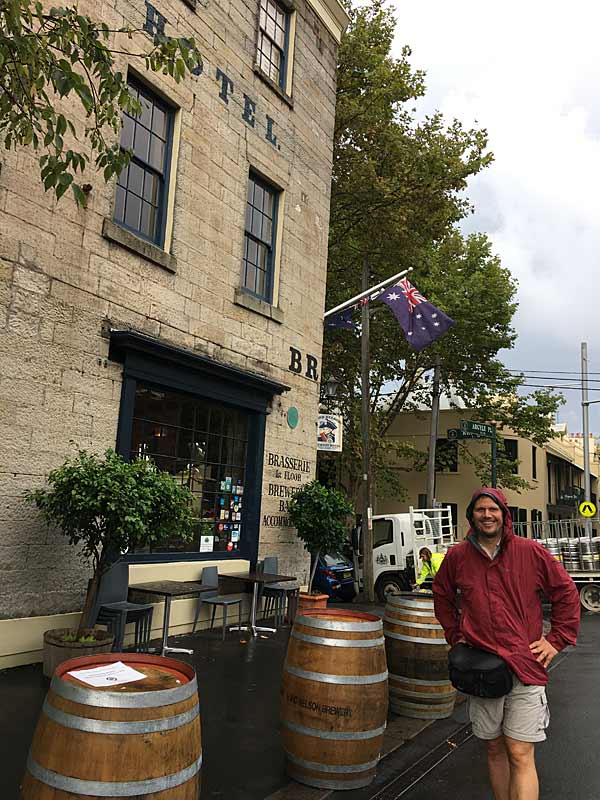SYDNEY, AUSTRALIA — We had an appointment to keep at The Rocks, where the European part of Sydney history started with the arrival of the First Fleet.
We still hadn’t seen our Airbnb hostess, though. “I miss Karen and Rob,” Torsten said. “’How was your day? Shall I make you a cup of tea?’ ” Okay, so we’re spoiled.
We took the bus to The Rocks and presented ourselves to Margaret, our tour guide, who started out with a little boo-boo. “When we first discovered” — she caught herself — “came to Australia … ”
People already were living there, of course. But unlike the Maori in New Zealand, they were split into hundreds of clans and spoke hundreds of different dialects, and they didn’t immediately kill anyone they perceived as a threat.
In addition, an odd coincidence protected Capt. Arthur Phillip when he arrived with 11 ships: He had a tooth missing on the right side of his mouth, so he looked like one of the local Cadigal clan, whose manhood-initiation rites included removing a tooth on the right side.
Phillip had hand-picked the 789 convicts, primarily for youth and strength. Most had committed such petty crimes as stealing food — master bricklayer and builder James Bloodworth, who became perhaps the most valuable member of the colony, had stolen one gamecock and two hens and could have been hung in England.
They got to work hewing a life out of The Rocks, named because it was just a pile of limestone on the sea; palm trees and sand beaches came later. The women crushed and cooked seashells to provide lime for cement, many going blind from the resulting sulfur fumes. The men swung pickaxes, the only sharp tool allowed.
You still can see their pick marks on stone buildings just a stone’s throw from the cruise ships, perhaps while walking on Scottish cobblestones that arrived as ship ballast.

Today, having an ancestor who came on one of the First Fleet ships is like having one who arrived on the Mayflower.
“When I was growing up, teachers didn’t want to talk about the convicts, and nobody wanted to be the descendant of one,” Margaret said. “Now, that’s completely flipped.”
She led us through a warren to hidden lanes and alleys that are open to the public but rarely found — we hadn’t noticed them at all the day before. We saw the old brothel area, in which young women would disappear if they mistakenly stumbled into it, and the stone walls of the first houses, with metal representations of the furniture that would have been there.
She showed us where to get the best view of the harbor once the cruise ship leaves at 6:30 p.m. — up to eight can dock in Sydney Harbor, but only one at the coveted slip on Circular Quay. And she showed us a fountain commemorating Mary Raibey, perhaps the country’s favorite ex-convict.
Raibey was 14 years old when she dressed up as a boy and took the neighbor’s horse for a ride. Shipped to Australia for her prank, she eventually became a successful businesswoman and now is pictured on the $20 bill. She wasn’t the youngest convict, Margaret said; the youngest was 7.
If convicts did well, they were pardoned and often given opportunities or even land. But the small Cadigal clan just faded away. Some of their words are used on signage, but virtually all come from the journals of marine Lt. William Dawes, who studied the language with the help of a 15-year-old girl named Patyegarang.
Despite the historic value of The Rocks, the city nearly tore it down in 1970 to put up apartment towers. Building unions spearheaded protests on behalf of the blue-collar “wharfies” who lived there, and the plans were shelved. Now, there’s a Green Ban —if you tear down a building that’s more than a century old, you can’t put up anything in its place.
Away from the cruise terminal, ferry quay and visitor information center, The Rocks isn’t that touristy. All of the shops and restaurants are tiny and locally owned. We bought lunch at La Renaissance patisserie — flaky meat pies and the most Paris-worthy strawberry tarts we’d ever eaten — which turned out to have its own hidden stone nook in back.

The Lord Nelson is the oldest pub in Australia.
It had started to rain, but we put on jackets and made our way to the new Barangaroo Reserve, passing the Lord Nelson Brewery Hotel, established in 1841 and now the oldest pub in Australia, and the newly restored Hotel Palisade in the tiny Millers Point neighborhood.
The new park, on a high point between Darling Harbor and Circular Quay, has spectacular views and walkways on three levels of stone terraces (see photo above). No one was there except us, a few runners and an indigenous man who appeared to be giving a tour.
But we were getting soaked, and Torsten’s water shoes were giving him blisters. So it was back to the bus and a quiet night at the cottage.

March 16, 2017 at 6:22 am
PBS Victoria show had Chartist rebels who were going to be drawn and quartered, instead on Victoria’s orders sent to Australia. Love waking up to your stories!